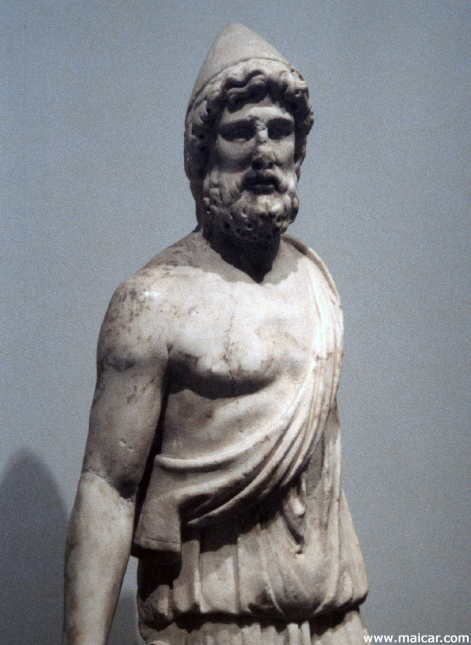Question: For all of us laymen of mythology/casual gamers of Scion; can the wise ones please provide a brief list of tenants, rules and/or taboos for the pantheons? (If this has already covered please forgive the search engines and my ineptitude). Essentially, what are some of the religious practices and taboos your players are held to?
Man, taboos! They're fun to talk about, and everybody has them, to the point where it's just everyday life for our PCs and they sigh and go about their business and rarely even ask the universe why them anymore. It's a very big question and we'll have to just do a quick top-responses kind of answer, but still a very neat topic.
The Aesir. The Norse gods are among the easiest on this list, actually; pretty much all you have to do is be courageous and follow directions from the people in charge and you're usually good. If you fuck up and take something away from its rightful owner - whether by theft, accidental destruction of property, political snafu or killing someone who belongs to or is the family of another person - you have to pay weregild, which is the blood price of that dead or destroyed thing and is agreed upon between yourself and the injured party (loosely agreed upon; they will often just tell you and you will have to deal with their demands because you're in the wrong here). The major taboos of the Aesir are kinslaying, which is immediately punishable by swift and nasty death, and the blurring of traditional gender lines, which won't get you killed but will get you ostracized, disliked and ridiculed for a very long time. Those who want to travel the smoothest road among the Aesir usually don't ask too many questions, do their jobs and never set foot outside the usual accepted ideas of what men and women are supposed to be like and do.
The Amatsukami. The Amatsukami place massive importance on ritual and spiritual purity and cleanliness, so most of their taboos are centered around preserving and respecting that idea. Doing anything religious while dirty, unpurified or polluted in some way is forbidden and deeply offensive to the gods and shrines that you might dirty, and that includes not just physical dirt but illness, mental imbalance or emotional turmoil, causing damage to any living thing or natural feature of the world, and even familial connections (for example, if someone in your family has recently died, you're unclean for a while).
The Anunna. The biggest taboo in the Mesopotamian pantheon is sassing, questioning or disobeying orders from any god senior to you (which is all of them for most of a Scion's life). This is not like every pantheon wants you to follow directions; this is serious, life-is-over-if-you-disobey business. Do not do it. Ever.
The Aztlanti. The Aztec gods are kind of neurotic, which leads to them having a number of cultural and religious hang-ups for young Scions to navigate. Sexuality is heavily controlled, meaning that any deviation from what they would consider normal behavior - including homosexuality, promiscuity, transgenderism, adultery and basically anything else except married missionary - is likely to get you in trouble (if
Tlazolteotl is around,
severe trouble). As a member of a pantheon with a very strong sense of community and loyalty, betraying anyone related to you in any way, even if for the greater good, will probably be the end of you, and since they strongly believe that blood sacrifice is necessary for the continuation of the universe, refusing to participate in it is tantamount to betraying everybody all at once. The sacred calendars (the
tonalpohualli and
xiuhpohualli) also strongly govern various activities and festivals, the fortune and futures of those born on them and the days where it is taboo to do anything (the
nemontemi or "dead days" at the end of the calendar).
The Bogovi. These guys are easy! They are violently and completely opposed to the interference of the divine with humanity, at all and in any way. It is completely forbidden for gods, lesser immortals or any other kind of magical creatures to have contact with or affect the doings of mortals, and whenever it happens it's punished with swift and uncompromising disapproval. Unfortunately for Scions, that means they're breaking the greatest taboo of their people just by existing, and there's not much they can do about it; even their futures after the war with the Titans are uncertain, especially if they haven't yet ascended to godhood and left behind their mortal beginnings.
The Celestial Bureaucracy. Popular Buddhism and Shenism, the Chinese folk religions that includes most of the god-worship still practiced today, are heavily focused around the idea of good fortune and what people can do to court it and stave off bad luck, often by currying the favor of various gods and spirits or observing the astrological conditions at hand. As a result, there is a literal metric shit ton of small taboos involved for everyone, from what you can and can't eat at certain times to what kinds of gifts are required for various religious festivals and which ones are terrible to what you should wear, where you should go, what you should look at and what will happen if you do any of these things wrong. As a generalization, neglecting any ritual or religious act that you are supposed to perform (veneration of ancestors, upkeep of shrines, observance of festivals and so on) will break a barrel of taboos, so most Chinese Scions are probably on constant point to keep things going the way they're supposed to. Note, however, that China contains a ton of gods from various different religions who all have their own small observances and taboos, so it's nearly impossible to do a real "overview". Individual Chinese Scions will have to research what their specific part of which religion is doing to get good particulars.
The Devas. Well, there's the ever-popular prohibition against
Illusion, which is the great deception that prevents most of the world from breaking the shackles of samsara and achieving enlightenment and spiritual transcendance. The famous taboo against eating beef or harming cattle, because they are specifically protected in the Vedas and often appear as forms of the gods, is also still alive and well in many parts of modern India, and certainly important to the gods who have been around for centuries. Beyond those, taboos are largely dependent on the caste system, which modern Scions may have to figure out their place in and learn about before trying to interact meaningfully with others; members of different castes would in ancient times have been subject to very different rules and taboos, and many of the Devas, especially the old-school ones, might place varying levels of importance on them.
The Dodekatheon. We're familiar with most of the major rules for these guys: don't commit kinslaying, don't be hubrisful in front of the gods, don't commit incest (unless you're Zeus or he has approved the union). In addition, despite the fact that the ancient Greeks were somewhat famous for their homosexuality, such relationships were strictly governed by age and expected to conform to the older man + younger boy model; a formal relationship between two adult men would be considered deviant, and if the men in question also refused to have wives or female concubines, bizarre (and to make life even harder for male homosexual Scions, fellatio was also a serious taboo, considered demeaning to both parties). Illegitimate children are also pretty taboo (unless unacknowledged children of concubines, of course, everybody has those!), meaning that you need to have legitimate children with a wife to carry on your family and that having a child through adultery is a violently punishable offense. There's a pretty full surviving calendar of religious festivals for various members of the Dodekatheon as well, especially their Roman versions, and it's prudent for Scions to observe them for best relations with their gods. Finally, there is a very strong taboo against breaking any of the rules of sacred hospitality: it was a social sin not to provide relief and shelter for travelers or visitors, and in return a terrible breach for said visitors and host to in any way act against one anothers' goodwill.
The Orisha. Like the Polynesians who aren't on this list yet, the Orisha are hard to pin down because their taboos might vary over time, covering whatever a god, priest or societal agreement had labeled "taboo" at a particular time. Things that were generally taboo, however, usually included touching a ritual or religious relic or item if you were not a priest or pre-approved to do so, incest, speaking ill of the dead and insulting an authority figure. Various foods were often also taboo, either because they might cause illness or because there was a shortage of them and they couldn't be common foodstuffs.
The Pesedjet. There were a lot of ancient Egyptian taboos, ranging from crossing borders to not touching menstruating women to trespassing on temple grounds to eating any animal earmarked to be sacrificed to a god. The most important things to avoid are generally those that offend or affront religion in some way; touching (or, god forbid, stealing) religious relics is a major taboo that usually ends in disaster, while entering temples that aren't open to the public (a lot of temples in ancient Egypt had priest-only areas or were only open during certain festivals), affronting the pharaoh who represents the gods, stealing from or preventing temple tithes or impeding construction of tribute or religious items, and so on. Like the Devas, the Pesedjet have a lot of god-specific taboos that may apply only in their territories or to their people as well, such as Bastet's prohibition against the harm of cats. (Scions would probably do well to observe those normally even when they don't necessarily have to, though, just to cut down on possible problems.)
The Tuatha de Danann. Don't break your geasa, kids. Nothing will make you persona non grata as quickly as that will, and most cases in Irish myth of people breaking a taboo are personal and easily interpretable as geasa. Like the Dodekatheon, they also have strong prohibitions against harming travelers or breaking the rules of hospitality.
The Yazata. There are tons of prohibitions and taboos in Zoroastrianism, almost all of which the Yazata are likely to enforce and require their Scions to adhere to. Anything unclean is massively taboo and not only cannot be touched by the pure, but often can't be disposed of anywhere that would pollute the world by touching the ground or defiling sacred fire. Death is a powerful polluter, making it taboo to touch or handle any dead person without specific rituals, and some fringe groups in the religion even extend this to animals, making it taboo to eat their flesh because it means ingesting something impure. Menstruation is another major polluter, resulting in menstruating women being forbidden to touch, look at or be in the presence of anyone else during that period of the month, and further only being allowed to eat or touch certain foods and substances (one of the weirder rules here is that, because they would pollute water by touching it, they can only wash themselves with bull piss). Also, the most famous taboo is against lying, which is considered inherently evil no matter how good your intentions might be, and which always aids Angra Mainyu, the malignant Titan.
By the way, you're not inept and this hadn't been directly answered before. However, you might also find this old post about
the central themes of each pantheon useful.







